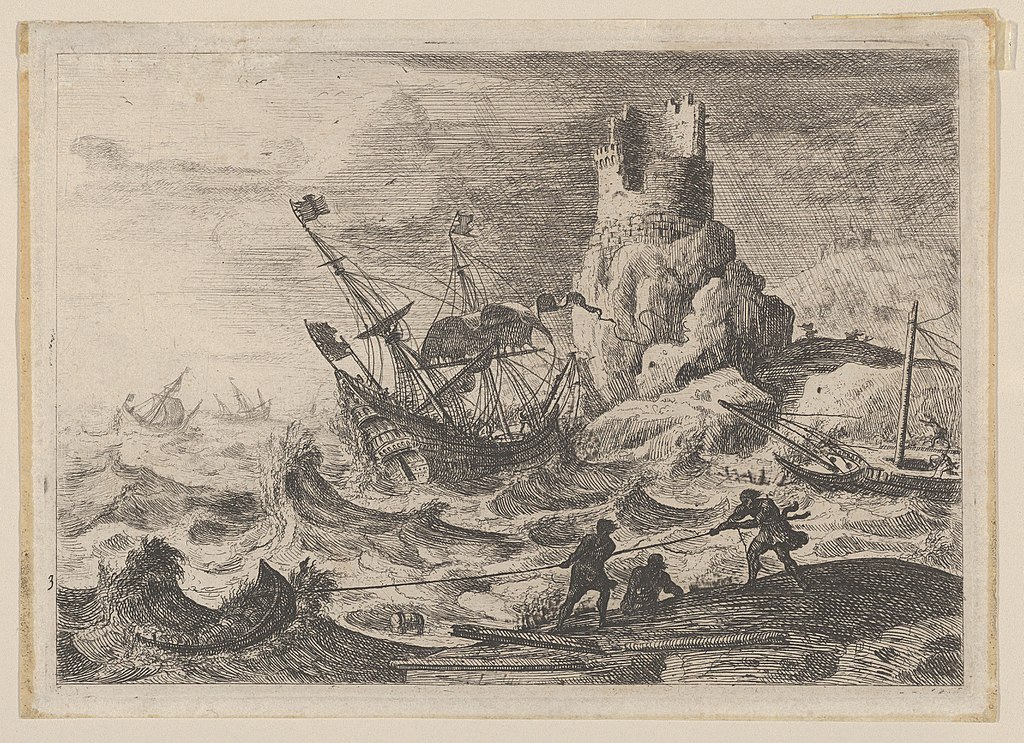While many of Shakespeare’s plays begin with a pair of characters talking about what had happened recently, The Tempest opens with a spectacular bang. A crew of sailors try to keep their ship afloat during a terrible storm, shouting to the passengers (including their king) to shut up and stay out of their way. The play throws the audience in the midst of an overwhelming crisis, pumping the adrenaline from the start. Of course, in the next scene, we learn that the storm was created by magic and that no one on the ship was actually harmed. But before we come to that scene, we watch a group of people at the mercy of nature’s awe-inspiring power.
Shakespeare used storms and shipwrecks in many of his plays. In the opening scene of The Comedy of Errors, Egeon tells a sad story of how his family was separated at sea many years ago. Twelfth Night begins with Viola washed ashore in Illyria after a shipwreck, separated from her twin brother, Sebastian. Pericles, a play mentioned many times in Lauren Gunderson’s The Book of Will, also includes a scene where the titular character finds himself in an unfamiliar land after his ship is destroyed in a storm.
What is the dramaturgical function of a shipwreck in a storm? Similar to the fantastical tornado in The Wizard of Oz, such events transport characters to unfamiliar settings, setting the stage for drama: exploration, discovery, new encounters. If some characters are split up during the shipwreck, it also sets up a nice reunion scene in the fifth act. Until loved ones are reunited, shipwrecks can cast a doleful shadow over an overwise lighthearted story. In The Comedy of Errors¸ the Duke of Ephesus is so moved by Egeon’s woeful story of losing his wife and one of his sons in the accident that he is tempted to pardon the man sentenced to death. In Twelfth Night, Viola mourns the loss of Sebastian even as she is entangled in a love triangle while disguised as a young man. In The Tempest, King Alonso and his son Ferdinand each believe that the other has drowned at sea. In Ferdinand’s case, he is partly swayed by Ariel’s sad and mysterious song.
Full fathom five thy father lies.
Of his bones are coral made.
Those are pearls that were his eyes.
Nothing of him that doth fade
But doth suffer a sea change
Into something rich and strange.
Sea nymphs hourly ring his knell.
(The Tempest, Act 1, Scene 2)
Ariel’s song, while somber, is also strangely comforting, encouraging Ferdinand to come to terms with his father’s eternal slumber at the bottom of the ocean. This puts the young man in an emotionally vulnerable place that makes his reunion with his father at the end all the more impactful.
Especially in his late plays, including The Tempest, Shakespeare was drawing from the classical genre of romance, which flourished in Hellenistic culture during first and second centuries. Romance in this case is less about love and marriage; these were stories that usually involved sea voyages and fateful shipwrecks, as well as separated lovers, pirates, and miraculous turns of events. So, these stories harken back to a historical period and culture when the Mediterranean Ocean was the highway connecting the known world.
We know that the island in The Tempest is somewhere in the Mediterranean, since the ship that meets the storm at the beginning of the play was returning to Europe after a trip to Tunis in North Africa. But scholars have noted that Shakespeare may have also been thinking about sea travel in the Atlantic Ocean when he wrote The Tempest. This was, after all, the Age of Exploration and a time when European colonization of the so-called “New World” was ramping up. The Virginia Company was founded in 1606 and established the colony of Jamestown in 1607, only a few years before The Tempest was performed at court in 1611.
Some parts of the play suggest that Shakespeare was influenced by his society’s growing curiosity about the Americas and the Indigenous peoples there. In Act 2, Scene 1, Gonzalo imagines in great detail a utopian society without rulers or governments, economic disparity, or hard labor. This speech is based on the French philosopher Michel de Montaigne’s essay “Of Cannibals,” with some parts matching almost exactly. In this essay, which was translated and published in England in 1603, Montaigne inverts the commonly held distinction between “civilized” and “barbarian,” arguing that, to the Indigenous peoples in the Americas, the Europeans might be the “savages” living in a corrupted society. Passages such as Gonzalo’s speech links this Mediterranean romance to contemporary encounters in the New World, adding extra layers of meaning to Caliban, who is at times called a “savage” and “monster” by the European characters. (Even his name is reminiscent of the word “cannibal.”)
Interestingly, Shakespeare may also have been considering a real-life shipwreck in the New World when he was writing The Tempest. Although there is no concrete evidence, scholars generally agree that Shakespeare would have had access to a written account by William Strachey, who was aboard the Sea Venture when it met a hurricane, was separated from the rest of the fleet headed to Jamestown, and beached on an island in the Bermudas in 1609. Strachey’s account gives a vivid description of the ship tossing in the storm and the fear of death he felt: “there was not a moment in which the sudden splitting or instant oversetting of the ship was not expected.” But miraculously, all 150 passengers of the ship safely made it to land—which also happens in Shakespeare’s play. Strachey describes the uninhabited island as almost a paradise, where there was plenty of food and fresh water—this echoes Caliban’s lines about fertile soil, freshwater springs, berries, and fishing spots on the island. The crew of the Sea Venture built two small ships over the next nine months and successfully completed their journey to Jamestown the following year. But apparently some of the crew did not want to leave the bountiful island and attempted an insurrection—lining up with the many attempts to overthrow an authority figure in The Tempest.
Of course, these similarities may be coincidental. Some argue that Shakespeare could not have had access to Strachey’s essay as it was not published until 1625, although it could have been circulated earlier in manuscript form. But whether or not he was influenced by this specific incident, it does seem plausible that Shakespeare, like many others around him in the early 17th century, were noticing that there was more news every day of encounters in the New World. And combined with his familiarity with stories of sea travel and shipwreck in the Mediterranean, these reports may have evolved into the unique island setting of The Tempest.


